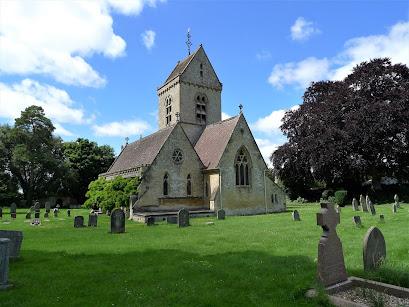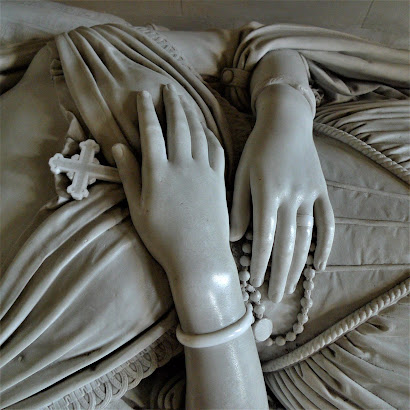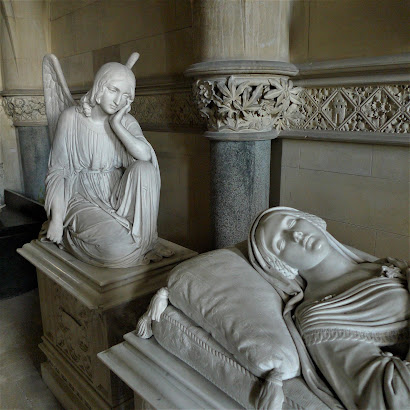The monument and chapel are both influenced by the Gothic Revival movement of the time. The white marble recumbent sculpture depicts Lady de Mauley in the pose of ‘not dead but asleep’ so beloved in the 1800’s. Wearing a Victorian neo-medieval dress she lies serenely, carved in beautiful natural detail, on a mock Gothic tomb-chest which is flanked by two free-standing kneeling ‘guardian angels’ one gazing down at her while the other looks to Heaven. The tomb-chest as well as the two plinths bear inscriptions. Lady Barbara died at the age of 55 but is portrayed as a young woman. Is this a reference to the medieval practice of showing women at an idealised age of thirty, the age at which it was believed Christ died and hence would be at the Resurrection? Or did Lord de Mauley wish to remember his wife at the time they married? It is unlikely that Monti ever met Lady de Mauley but there was a portrait by the fashionable painter John Hoppner (1758-1810) which could have been used to obtain her likeness. Lady de Mauley was the daughter and sole heiress of the 5th Earl of Shaftesbury. She married William Ponsonby, the 3rd son of the 3rd Earl of Bessborough, in 1814 when she was 25. When he was created a Baron at the time of the Coronation of Queen Victoria in 1838 he revived the Mauley Barony in his wife’s family, that was created by writ in 1295 but became extinct in 1415. He added the ‘de’ for Gothic effect thus returning the name to its original form.
The monument, the chapel and the sculptor are all of interest. Although rosaries were not uncommon on monuments in the Middle Ages they disappeared from monuments at the time of the Reformation along with other ‘popish’ symbols. It is therefore surprising to find that Lady de Mauley is shown with a cross and in her left hand holds a rosary, which may be unique in a monument of this time. It is known that the de Mauleys were ‘high church’ and Hatherop was a centre of Roman Catholicism between the late 17th and early 19th centuries. When Sir John Webb was living at Hatherop Castle it contained a Roman Catholic chapel. So it is possible that the de Mauleys may have requested a rosary; alternatively it may have been due to the Italian sculptor not appreciating English sensibilities. On her left arm Lady de Mauley wears a bracelet depicting a serpent biting its tail. The Ponsonby crest does contain a serpent but here it is more likely to be the well known symbol for eternity, representing immortality, which was fashionable at the time.
The mortuary chapel too, is unusual. It was designed in a flamboyant French Gothic style most likely by William Burges. It is also likely that he was responsible for the frieze that extends around the chapel featuring leaves, flowers and some motifs associated with Lady de Mauley. Above Lady de Mauley the frieze contains the letter ‘B’ for Barbara and to its right is shown a butterfly. The butterfly represents the soul rising to Heaven and occurs on a number of Victorian memorials and paintings. The frieze also contains a number of towers which are an allusion to the patron saint of Lady de Mauley, St Barbara. This is another Gothic Revival feature as there are examples from the medieval age where the patron saint of the deceased appears on monuments.
Although the existence of St Barbara is of doubtful veracity her cult became popular in the Middle Ages especially in France. It was claimed that Barbara’s father imprisoned her in a tower so no man could see her. She subsequently converted to Christianity and eventually died a virgin-martyr. As a punishment for his cruelty her father was struck dead by lightening. This led to St Barbara becoming the patron saint of those who could suffer sudden death such as miners and gunners.
The sculptor Raffaelle Monti was born in Switzerland in 1818, brought up in Milan and died in London in 1881. He was a member of the Risorgimento (the Resurgence) a movement formed to fight for independence of Italy from the Austrians. As a senior officer of the National Guard of Milan he fled to England in 1848 when the Italians were defeated at the Battle of Custozza. He carved the de Mauley monument in the same year. He had visited England prior to this when he carved the ‘The Veiled Vestal’, a young woman wearing a veil, for the 6th Duke of Devonshire. This statue is on display at Chatsworth House and was instrumental in bringing him to the attention of the British public. Like many of the sculptors of his time as well as accepting commissions for sculptures, he designed for many well known companies such as Garrards. Parian statuettes and busts of his designs were produced by Copeland and Wedgwood. In 1860 he assigned the production of his ‘Veiled Vestal’ to Copeland from which they produced the bust known as ‘The Bride’. Also like a number of other sculptors he found it difficult to make a living, becoming impoverished towards the end of his life and having to sell his tools to raise money.
The enduring appeal of his work can be gauged by the fact that an original Parian bust of ‘The Bride’ was recently sold at a local auction, realising £822. About the same time another Parian bust sold on ebay for £1500, where modern reproductions in Carrara marble were also for sale at a price of £90.
During a visit in the summer of 2011 we were dismayed to find that one of the wings was broken. The bottom part was lying on a ledge behind the monument. Returning in January 2012 we were delighted to find the wing had been repaired. Now that the monument has been restored to its former glory it will continue to enchant all those who see it.
Notes:-
The monument and chapel are described in Nicholas Penny’s book, Church Monuments in Romantic England.
General details on the life and works of Raffaelle Monti can be found in A Biographical Dictionary of Sculptors in Britain 1660-1851, edited by Ingrid Roscoe, Emma Hardy and M G Sullivan.
We thank the Cotswold Auction House Ltd for permission to reproduce their photograph of ‘The Bride’ used in their sale catalogue.





















